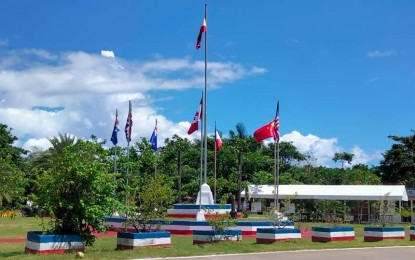
HISTORIC. The site of the former US Naval Depot in the island of Suluan, Guiuan, Eastern Samar in this undated photo. The local government of Guiuan in Eastern Samar on Tuesday (Oct. 19, 2021) said it is increasing awareness on the significance of their town in the history of Philippine liberation during World War II. (Photo courtesy of Janet Israel-Ramos)
TACLOBAN CITY – The local government of Guiuan in Eastern Samar is pushing for increased awareness on the significance of their town in the history of Philippine liberation during World War II.
On Sunday, a lecture for local tour guides was held focusing on the contributions of Suluan Raid in liberating the country from Japanese invaders and on the establishment of a large US Naval base in the town.
The Suluan Raid took place on October 17, 1944 or 77 years ago.
“The problem with commemoration is we forget its historical significance or importance. When we commemorative is to preserve the memory, but if you don’t understand that memory it is hard for you to celebrate,” said Kinna Mae Kwan, a young author who works for the local government, in a phone interview Tuesday.
“Our tourism officer wanted the lecture to be focused to our tour guides so that they will know what stories to tell when tourists come to our town,” Kwan added.
The local government will partner with the Department of Education (DepEd) to incorporate the historical significance of their local history in self-learning modules.
“Yes, a naval base was established in our town during the liberation which is factual, but we also need to tell them its significance. It paved the way to become the key in liberating the entire country,” Kwan explained.
Suluan is an island village in the Pacific part of Guiuan town.
This tiny island has a big contribution to the history of the country being one of the islands mentioned in the chronicle of Italian explorer Antonio Pigaffeta when the fleet of Ferdinand Magellan arrived in the country.
Before Gen. Douglas MacArthur landed on Leyte shores on Oct. 20, 1944, the US Navy 6th Ranger Battalion commanded by Col. Henry Mucci was the first American force to return to the Philippines with the mission of destroying coastal defense guns as well as radio and radar stations in Dinagat and Suluan Islands in Eastern Samar.
The rangers managed to disperse a small group of Japanese defenders and destroyed a radio station in Suluan while they found Dinagat unoccupied. They erected a navigation light for the amphibious transports.
This attack launched the Battle of Leyte Gulf.
Three days later, Gen. MacArthur landed at the Red Beach in Palo, Leyte, which signaled the start of liberation.
After the Suluan raid and successful liberation of Leyte and Guiuan from Japanese forces, the Allied Forces constructed the US Naval Base in Guiuan, one of the biggest naval bases in Southeast Asia and was the second largest in the Philippines.
It covers the villages of Sapao, Taytay, Tagpuro, Cantahay, Baras, Pagnimitan, and Sulangan in Calicoan Island and the islands of Manicani and Tababao.
The facility housed over 100,000 Allied Forces who worked alongside Filipino guerillas in freeing the country from the Japanese forces. (PNA)
